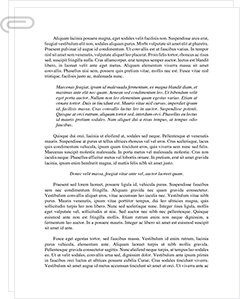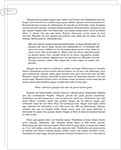 Study Document
Study Document
Medicare/Medicaid Current and Future Trends Research Paper
Pages:3 (838 words)
Sources:3
Subject:Government
Topic:Medicare And Medicaid
Document Type:Research Paper
Document:#39868717
This means that the program will need to support many more people than it currently does, and there will be fewer (proportionally) workers paying into the system (Johnson 2006). The particular problem cited and explored by this author is prescription drug coverage, with the researcher predicting ongoing volatility in coverage laws and particulars, but truly this trend has many far-reaching implications.
The aging of the U.S. population and the increased burden this places on the Medicare program is alarming for another reason, as well: despite ongoing efforts to correct the situation, over a quarter of Medicare payments go to beneficiaries and their providers in the last year of the beneficiary's life (Riley & Lubitz 2010). This is a problem for several reasons, not the least of which is that is represents a fairly inefficient use of Medicare dollars -- payments and benefits that improve the quality of life in earlier years and help to maintain health, rather than more fully covering hospital stays that tend to become quite lengthy during the end phases of life in this country could save money and improve the effectiveness of the program as well as the health of the country's elderly population (Riley & Lubitz 2010). As the proportion of beneficiary payments going out in the last year of life has not changed much in over thirty years, it is unlikely to change a great deal in the near future, meaning that many of the problems identified with healthcare in the elderly are going to persist.
Conclusion
Medicare and Medicaid are highly useful programs that are utilized out of necessity by many to receive the healthcare that they need. These programs are facing significant issues in the rising number of people enrolled in these programs to receive benefits, however, as well as in the aging population and inadequately/inefficiently met healthcare needs of these beneficiaries. If the programs don't adapt to these trends, far more significant problems will emerge.
References
Johnson, P. (2006). Changes in reimbursement rates and rules associated with the Medicare Prescription Drug Improvement and Modernization Act. American Journal of Health System Pharmacy 63(7):2-6.
Riley, G. & Lubitz, J. (2010). Long-Term Trends in Medicare Payments in the Last Year of Life. Health Services Research 45(2): 565-76.
Saleh, S. & Callan, M. (2006). Trends in Medicare Disproportionate Share (DSH) Distribution in U.S.…
Sample Source(s) Used
References
Johnson, P. (2006). Changes in reimbursement rates and rules associated with the Medicare Prescription Drug Improvement and Modernization Act. American Journal of Health System Pharmacy 63(7):2-6.
Riley, G. & Lubitz, J. (2010). Long-Term Trends in Medicare Payments in the Last Year of Life. Health Services Research 45(2): 565-76.
Saleh, S. & Callan, M. (2006). Trends in Medicare Disproportionate Share (DSH) Distribution in U.S. Hospitals: 1996 -- 2003 Journal of Health Care Finance 33(2):70-83.
Related Documents
 Study Document
Study Document
Future Trends Using Professional Interviews Response Content
Future Trends Using Professional Interviews Response Content The research in this study reports interviews with several clinical psychologists about their current practice and practice methods as well as about their opinions about the future of the practice of clinical psychology. Similarities and Differences of Professionals Interviewed in Their Approach and Treatment Settings One psychologist interviewed stated that she uses puppets to assist children in working out their problem and in stimulating the
 Study Document
Study Document
Medicare
1. The Evolution of Medicare: Tracing the History and Key Amendments This essay would explore the historical context of Medicare's inception, the societal and political forces that shaped it, and the significant amendments and reforms it has undergone since its establishment in 1965. It may involve an analysis of the original problems Medicare aimed to address and how the program has adapted to changing healthcare needs and economic conditions
 Study Document
Study Document
Future of Healthcare As It Relates to the Geriatric Population
Future of Healthcare as it Relates to the Geriatric Population Description and Problem Statement The geriatric population in the United States is growing and compared to the population of health care providers the geriatric population growth is advancing much more rapidly. This presents a problem in making provision of health care to the future geriatric population. While there is a growth in the demand for geriatric health care services, there is not
 Study Document
Study Document
Future of Radio What Is
He doesn't mention Apple's iPod, iPod Touch, and iPad, but those devices also pose a challenge for traditional radio broadcasting. People can "…select music that suits their individual tastes and many have wider repositories of music in their own libraries" -- thanks to the iTunes and similar services -- than are offered on the playlists of radio broadcasters (Picard, p. 1). Moreover, Satellite and Internet radio are offering "hundreds of
 Study Document
Study Document
Future of Nursing in Texas
Texas is one of the strictest states in the country for nurse practitioners who want to open their own clinics, requiring them to find a physician with the willingness and time to follow a complex set of rules. Those rules include requiring the physician to delegate prescriptive authority, review patient charts, make on-site visits or practice within a certain geographical distance of the nurse practitioner. It's a system many nurse
 Study Document
Study Document
Future Implications of Improving Health
0, 4.0, and 4.5 percentage points in FYs 1982, 1983, and 1984, respectively, for States whose growth exceeded certain targets, OBRA-81 also reduced eligibility for welfare benefits, thus making it harder for poor families to qualify for Medicaid (Klemm, 2000). The legislation of this era began to weaken this link by specifying eligibility criteria based on income in relation to Federal poverty guidelines. In 1991, spending controls were established, provider



